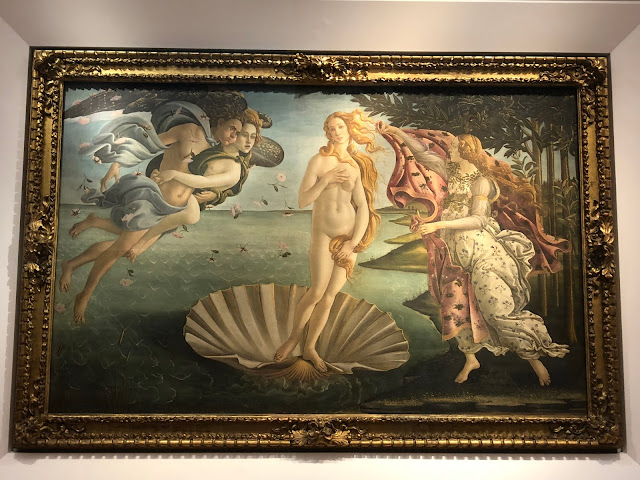【フィレンツェ】ウフィツィ美術館 ボッティチェリ ヴィーナスの誕生 Firenze - Gallarie degli Uffizi : Botticelli, The birth of Venus
『プリマヴェーラ』と並ぶ、ボッティチェリの代表作、『ヴィーナスの誕生』。
この作品は、『プリマヴェーラ』より少し後に描かれたと言われているが、同じくメディチ家のヴィラに飾られていた。
『プリマヴェーラ』とは違い、この絵は、ホラティウスの『変身物語』などに書かれている美の神ヴィーナスの誕生を忠実に描いている。
海の泡から生まれたヴィーナスが、風の神ゼピュロスに運ばれて、キプロス島に流れ着いて、季節の女神らに迎えられて、美しい衣を着せられる、というエピソードだ。
このヴィーナスのモデルは、シモネッタ・ヴェスプッチという女性で、ロレンツォの弟のジュリアーノ・デ・メディチの愛人だった人物と言われている。
ヴィーナスの取っているポーズは、この美術館にあるいわゆるメディチのヴィーナスと言われるヘレニズム期の彫像のポーズとよく似ている。
『プリマヴェーラ』と比べると、描かれている人物の数は少なくなっていて、全体的にバランスが整っている印象だ。
しかし背景の風景の描き方は、レオナルド・ダ・ヴィンチらの絵と比べると、遠近感は感じられない。
海に立っている波の表現を見ても様式的で、人物の表現や衣服の表現には気を遣っているが、それ以外の部分は、あまり力を入れていないように見える。
若い頃に共にヴェロッキオの工房で過ごしたダ・ヴィンチは、ボッティチェリの言葉として次のような言葉を紹介している。
”スポンジに緑の絵の具を浸して、キャンバスに投げつければ、背景の草々などは簡単に描けるさ”
この絵に対して、いろいろな文句をつけることは可能かもしれないが、この作品がイタリア・ルネサンスを代表する作品であることを、誰も否定することはできないだろう。
Along with "Primavera", Botticelli's masterpiece, "The Birth of Venus".
This work, which is said to have been painted a little after "Primavera", was also displayed in the Medici villa.
Unlike Primavera, this painting faithfully depicts the birth of Venus, the god of beauty, as described in Horace's Transformation Story.
In this episode, Venus, born from the bubbles of the sea, is carried to the wind god Zephyrus, flows to Cyprus, is welcomed by the goddesses of the season, and is dressed in beautiful clothes.
The model of Venus is a woman named Simonetta Vespucci, who is said to have been the mistress of Lorenzo's younger brother Giuliano de'Medici.
The poses taken by Venus are very similar to the poses of the so-called Medici Venus statues of the Hellenistic period in this museum.
Compared to "Primavera", the number of people depicted is smaller, giving the impression that the overall balance is in place.
However, the way the background landscape is drawn does not give a sense of perspective compared to the paintings by Leonardo da Vinci and others.
The expression of the waves standing in the sea is also stylized, and although he pays attention to the expression of people and clothes, the other parts seem to be less focused.
Da Vinci, who spent his youth together in Verrocchio's workshop, introduced the following words as Botticelli's words.
"If you soak the green paint in a sponge and throw it on the canvas, you can easily draw the grass in the background."
It may be possible to make various complaints about this painting, but no one can deny that this work represents the Italian Renaissance.
(Translated by Google Translate)



コメント
コメントを投稿